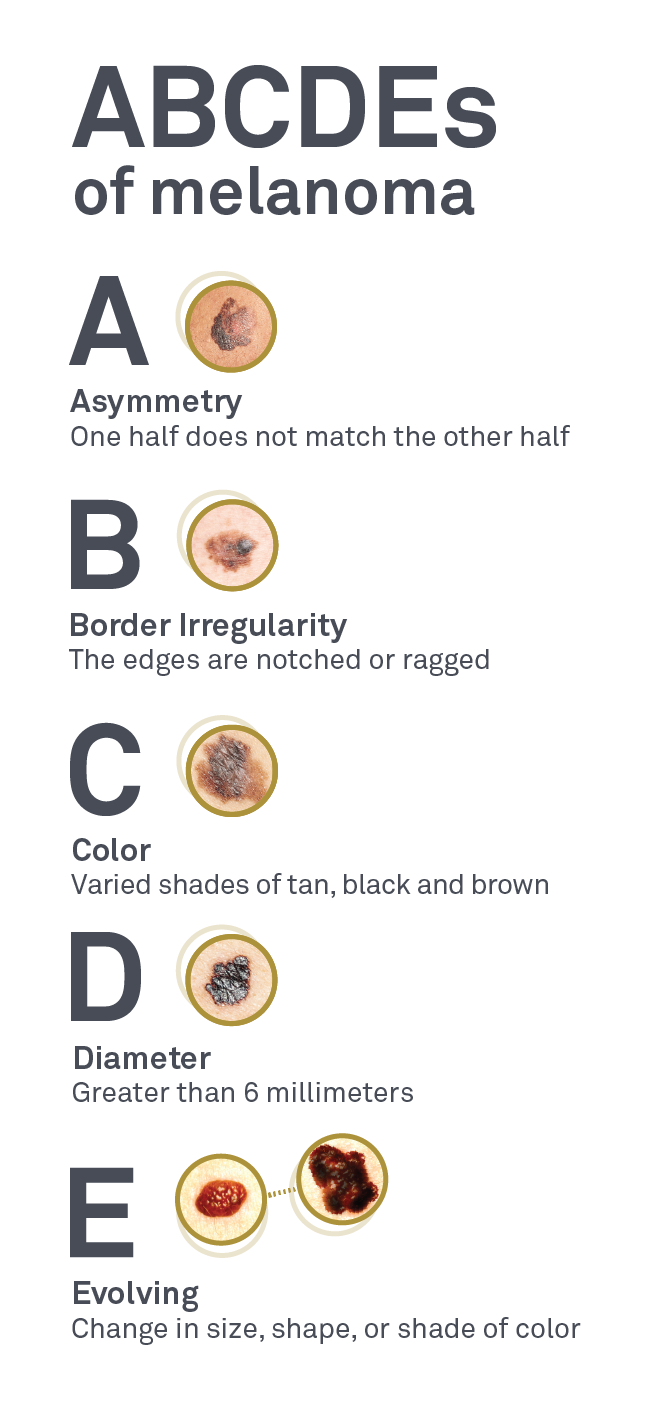
Melanoma: Early Detection and Challenges During the Pandemic
In the United States, the most common form of cancer is skin cancer.1 Melanoma accounts for only 1% of skin cancer cases but is responsible for most skin cancer deaths.2 However, if detected and treated early, melanoma is curable in almost all cases.3
This article will discuss melanoma and the importance of early detection. Challenges, approaches, and recommendations for screening and treatment during the pandemic will also be discussed.
Melanoma in the United States
The American Cancer Society (ACS) estimates that in 2021 about 106,000 new cases of melanoma will be diagnosed, and about 7,000 people will die from melanoma.2 The incidence of melanoma has been steadily increasing for the past 30 years and is expected to continue to increase.4 However, changes in incidence vary with age group. For example, the increased incidence observed from 2006 to 2015 can be mainly attributed to older adults5; the average age at diagnosis is 65 years. During the same period, the incidence among adolescents and young adults decreased.5
Risk Factors and Prevention
The leading risk factor for melanoma is exposure to ultraviolet (UV) light from the sun or artificial sources such as tanning beds, especially if sunburn occurs.6 Other risk factors include a light skin complexion (low pigmentation and increased sensitivity to UV exposure), the presence of congenital and acquired melanocytic nevi, and a family history of melanoma (see Sidebar).4,6,7
Melanoma is one of the most preventable forms of cancer. Prevention measures include counseling in primary care settings, which has been shown to modify behavior and decrease intentional tanning.8 The United States Preventive Services Task Force (USPSTF) recommends that clinicians counsel patients with fair skin who are 10 to 24 years old to minimize their exposure to sunlight and artificial UV light to decrease their risk of developing melanoma.4 The ACS recommends that persons at increased risk of getting melanoma7,9
- Avoid prolonged exposure to midday sun
- Wear a wide-brimmed hat
- Wear tightly woven clothing that covers arms and legs
- Wear sunglasses that block both UVA and UVB rays
- Use a broad spectrum sunscreen with an SPF of 30 or higher
- Avoid indoor tanning
Early Detection
When diagnosed and treated at an early stage, melanoma is one of the most curable cancers. The 5-year survival rate for persons with localized melanoma who are treated is 99%, as compared to 66% for those with regional metastasis and 27% for those with distant metastasis.3 However, newer treatments such as immunotherapy have improved the outcomes of melanoma with regional and distant metastasis, with 5-year survival rates exceeding 50% for select patients.10
Visual screening during a total body skin examination (TBSE) is an easy and effective way to detect new or changing moles. Patients are encouraged to examine themselves each month to identify suspicious moles.11,12
Challenges for Melanoma Screening and Treatment During the Pandemic
Diagnosis rates of many cancers decreased dramatically during the pandemic, owing to delays or avoidance of routine medical care.13,14 For melanoma, strategies to improve diagnosis rates include the use of telemedicine, stratification of persons at increased risk, and novel apps that compare serial images of suspicious lesions.15,16
A number of professional organizations including the National Comprehensive Cancer Network® (NCCN), ACS, American College of Mohs Surgery (ACMS), British Association of Dermatologists (BAD), and British Society for Dermatologic Surgery (BSDS) have made treatment recommendations for patients with cutaneous melanoma during the pandemic, and have suggested that short delays for select patients with very early disease may be acceptable.17-20
While short delays for diagnosis of very early stage disease may be acceptable, recent studies suggest that longer delays may be cause for concern. For example, a modeling study predicted that with a 1-month delay, 21% of patients would progress to the next tumor stage. In contrast, with a 3 month delay, 45% would progress to the next tumor stage.21 In Italy, the mean Breslow thickness (an indication of disease progression) of primary melanomas at diagnosis was found to be significantly greater after the lockdown ended than before it began, suggesting that delayed diagnosis was associated with more advanced disease.22
Risk Factors for Melanoma4,6,7
- Aged 35 to 75 years
- Personal history of skin cancer
- Family history of skin cancer
- Light skin
- Blond or red hair
- More than 40 moles
- 2 or more atypical moles
- Many freckles
- Sun-damaged skin
- History of blistering sunburn
- History of indoor tanning
How the Laboratory Can Help
Dermpath Diagnostics, a Quest Diagnostics company, offers a comprehensive test menu for dermatological needs, including testing of skin biopsies with analysis performed by board-certified dermatopathologists. In addition to tests for heredity and tumor burden, Dermpath offers BRAF/c-KIT testing for patients with metastatic melanoma.23 Dermpath and Quest also offer companion diagnostic tests including PDL1 IHC 288 pharmDx test, used to detect PDL1 expression in melanoma tissue; Melanoma, BRAF V600 Mutation, Cobas®; and Melanoma, BRAF V600E and V600K Mutation Analysis, THxID™.23 Together with microsatellite instability testing, these tests help identify candidates for targeted immune therapy.6
The website Spot the Spot™ (SpottheSpot.org) has also been developed by Dermpath Diagnostics to educate patients on how to protect and inspect their skin to help prevent and identify skin cancer and other skin-related conditions.
Note: Dermpath and Quest contract independently with insurance companies.
References
- Skin cancer (including melanoma)—patient version. National Cancer Institute. Accessed March 17, 2021. https://www.cancer.gov/types/skin
- Key statistics for melanoma skin cancer. American Cancer Society. Revised January 12, 2021. Accessed March 17, 2021. https://www.cancer.org/cancer/melanoma-skin-cancer/about/key-statistics.html
- Survival rates for melanoma skin cancer. American Cancer Society. Revised January 29, 2021. Accessed March 17, 2021. https://www.cancer.org/cancer/melanoma-skin-cancer/detection-diagnosis-staging/survival-rates-for-melanoma-skin-cancer-by-stage.html
- Johnson MM, Leachman SA, Aspinwall LG, et al. Skin cancer screening: recommendations for data-driven screening guidelines and a review of the US Preventive Services Task Force controversy. Melanoma Manag. 2017;4(1):13-37. doi:10.2217/mmt-2016-0022
- Paulson KG, Gupta D, Kim TS, et al. Age-specific incidence of melanoma in the United States. JAMA Dermatol. 2020;156(1):57-64. doi:10.1001/jamadermatol.2019.3353
- Leonardi GC, Falzone L, Salemi R, et al. Cutaneous melanoma: from pathogenesis to therapy (review). Int J Oncol. 2018;52(4):1071-1080. doi:10.3892/ijo.2018.4287
- Risk factors for melanoma skin cancer. American Cancer Society. Revised August 14, 2019. Accessed March 17, 2021. https://www.cancer.org/cancer/melanoma-skin-cancer/causes-risks-prevention/risk-factors.html
- Skin cancer prevention progress report. Centers for Disease Control and Prevention. Reviewed April 9, 2020. Accessed March 17, 2021. https://www.cdc.gov/cancer/skin/what_cdc_is_doing/progress_report.htm
- How do I protect myself from ultraviolet (UV) rays? American Cancer Society. Reviewed July 23, 2019. Accessed March 17, 2021. https://www.cancer.org/cancer/skin-cancer/prevention-and-early-detection/uv-protection.html
- Larkin J, Chiarion-Sileni V, Gonzalez R, et al. Five-year survival with combined nivolumab and ipilimumab in advanced melanoma. N Engl J Med. 2019;381(16):1535-1546. doi:10.1056/NEJMoa1910836
- Detect skin cancer: how to perform a skin self-exam. American Academy of Dermatology Association. Accessed March 17, 2021. https://www.aad.org/public/diseases/skin-cancer/find/check-skin
- What to look for: the ABCDEs of melanoma. American Academy of Dermatology Association. Accessed March 17, 2021. https://www.aad.org/public/diseases/skin-cancer/find/at-risk/abcdes
- Czeisler MÉ, Marynak K, Clarke KEN, et al. Delay or avoidance of medical care because of COVID-19–related concerns—United States, June 2020. MMWR Morb Mortal Wkly Rep. 2020;69(36):1250-1257. doi:10.15585/mmwr.mm6936a4
- Kaufman HW, Chen Z, Niles J, et al. Changes in the number of US patients with newly identified cancer before and during the coronavirus disease 2019 (COVID-19) pandemic. JAMA Netw Open. 2020;3(8):e2017267. doi:10.1001/jamanetworkopen.2020.17267
- Janda M, Swetter SM, Horsham C, et al. Virtual melanoma checks during a pandemic. Br J Dermatol. 2020;183(4):752-753. doi:10.1111/bjd.19255
- Petrie T, Samatham R, Witkowski AM, et al. Melanoma early detection: big data, bigger picture. J Invest Dermatol. 2019;139(1):25-30. doi:10.1016/j.jid.2018.06.187
- Short-term recommendations for cutaneous melanoma management during COVID-19 pandemic. National Comprehensive Cancer Network. Published May 6, 2020. Accessed March 17, 2021. https://www.NCCN.org
- COVID-19 (coronavirus) preparedness. American College of Mohs Surgery. Accessed March 20, 2021. https://www.mohscollege.org/UserFiles/AM20/Member Alert/COVIDAlert3March20.pdf
- Advice for dermatology HCPs during covid-19 pandemic. British Association of Dermatologists. Accessed March 17, 2021. http://www.bad.org.uk/healthcare-professionals/covid-19
- Baumann BC, MacArthur KM, Brewer JD, et al. Management of primary skin cancer during a pandemic: multidisciplinary recommendations. Cancer. 2020;126(17):3900-3906. doi:10.1002/cncr.32969
- Tejera-Vaquerizo A, Nagore E. Estimated effect of COVID-19 lockdown on melanoma thickness and prognosis: a rate of growth model. J Eur Acad Dermatol Venereol. 2020;34(8):e351-e353. doi:10.1111/jdv.16555
- Ricci F, Fania L, Paradisi A, et al. Delayed melanoma diagnosis in the COVID-19 era: increased breslow thickness in primary melanomas seen after the COVID-19 lockdown. J Eur Acad Dermatol Venereol. 2020;34(12):e778-e779. doi:10.1111/jdv.16874
- Schadendorf D, van Akkooi ACJ, Berking C, et al. Melanoma. Lancet. 2018;392(10151):971-984. doi:10.1016/S0140-6736(18)31559-9
Content reviewed 5/2021

